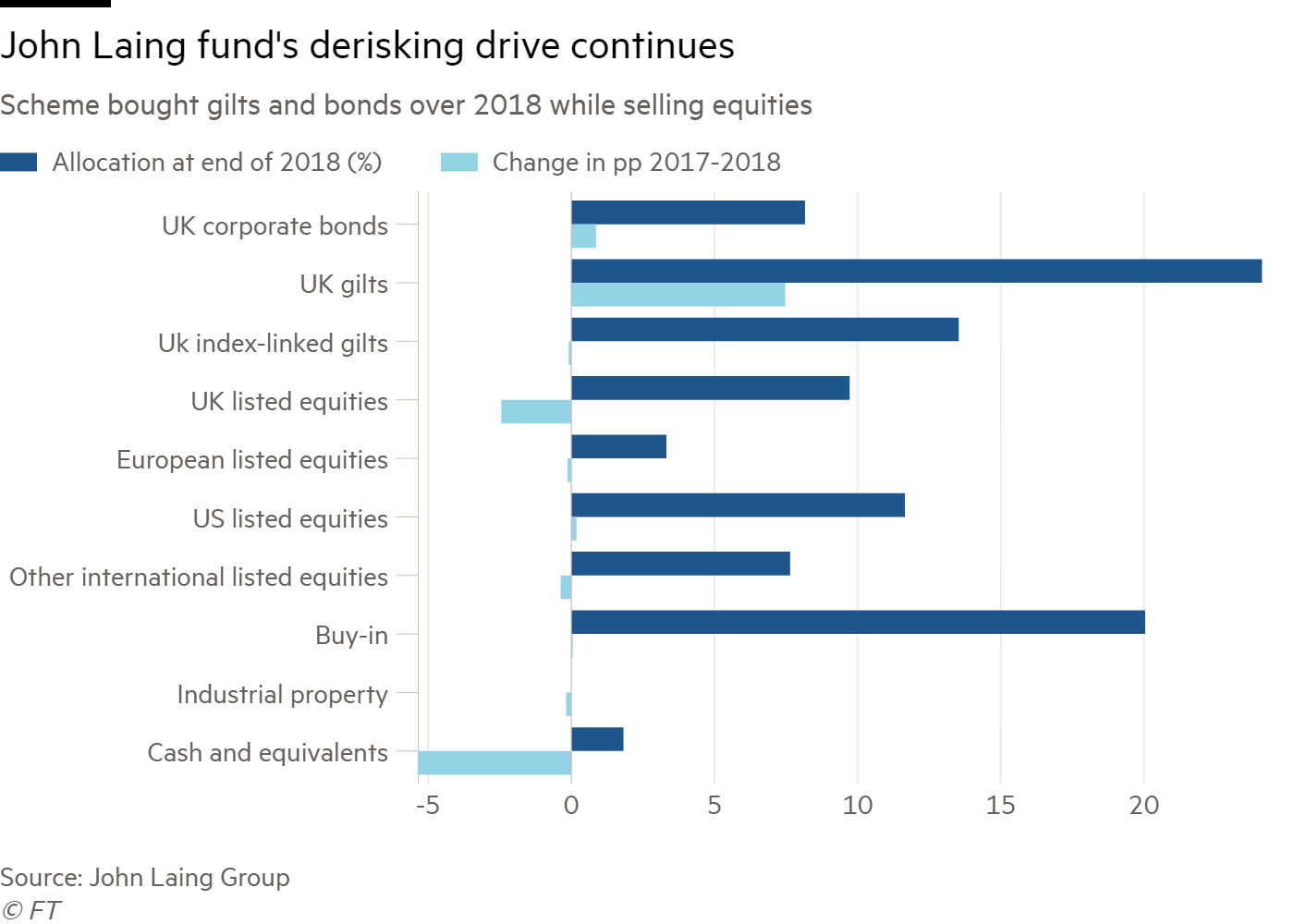The John Laing Pension Fund has sold its remaining stake in infrastructure company John Laing Environmental Assets Group, a holding initially contributed to the scheme as part of a contingent funding plan in 2015.
The sale and employer contributions see the scheme’s funding position stay stable, despite £21m of provisions being made for the equalisation of guaranteed minimum pensions, with sponsor John Laing Group saying the plan profited from excess demand for infrastructure assets among its defined benefit peers.
The £1.1bn JLPF ended 2018 with an accounting deficit of £32.6m – almost unchanged from £32.3m a year earlier – has hedged 95 per cent of its exposure to interest rate and inflation movements, and has embarked on a series of buy-ins with insurer Aviva. The scheme is targeting full funding on a gilts-flat basis between 2023 and 2028.
As low interest rates have swelled DB liabilities over the past decade, employers have made increasing use of alternative funding to raise the security of member benefits without further impacting their free cash flow.
JLPT has sold stock in the past to meet excess demand from long-term investors
John Laing Group spokesperson
Ahead of its initial public offering in 2015, John Laing made a £100m contribution to the scheme, made up of a combination of cash and equity interest in ongoing infrastructure projects.
A cash injection of around £21m was financed by the sale of John Laing’s interest in a Croydon urban regeneration project. The scheme also took a 29.9 per cent interest in John Laing Environmental Assets, known as JLEN, and a 47 per cent stake in the City Greenwich Lewisham Docklands Light Railway public-private partnership.
JLEN was separated from the John Laing Group when it was listed in 2014.
The scheme has gradually whittled down its exposure to these contingent funding structures, preferring to use the proceeds to construct a portfolio closely tailored to its liabilities.
“JLEN is the only ‘single’ stock that JLPT [the JLPF trustee] holds in the portfolio – everything else is through very diversified fund holdings designed to match their pension liabilities,” a spokesperson for John Laing explains. “JLPT’s original investment came about through an agreement with John Laing Group at the time of its IPO, notwithstanding this investment strategy.”
JLPF profits from infra demand
From an investment perspective, the sale of these infrastructure assets marks the scheme from DB peers, who have flooded into infrastructure due to its cash-generative properties and illiquidity premium.
Portfolio analysis by Pensions Expert’s sister title Mandatewire reveals that around £4.5bn of new mandates, reweightings to, and planned allocations to infrastructure were observed over 2018, significantly more than any other alternative asset class. Property was the next most popular asset class with inflows of around £2bn.
“While it has delivered attractive, inflation-linked dividends to investors, a holding in JLEN remains inconsistent with JLPT’s portfolio strategy,” the spokesperson continues.

The JLPF’s commitment to buy-ins – Aviva insurance policies are now its second-largest asset holding at £218m, second only to gilts at £671.6m – signals a significantly shorter time horizon than schemes aiming for self-sufficiency, explaining its appetite for liquidity.
Selling its former sponsor’s infrastructure assets has also benefited the scheme, with high demand from pension funds and insurers driving alternative asset prices up.
“JLPT has sold stock in the past to meet excess demand from long-term investors, with the most recent sale being at the end of 2018,” the spokesperson says.
“In light of its reduced position size following this sale and the strong share price high, JLPT has taken the opportunity to sell the balance of its holding.”
ABF should diversify covenant risk
Once a scheme has been given a contingent asset,such as the JLPF’s infrastructure interest, the move to sell is essentially an investment decision, says Alex Hutton-Mils, managing director at covenant specialist Lincoln Pensions.
“[John Laing] has been on something of a derisking journey,” he says. “If you’re thinking about some sort of buy-in or buyout at some point, it’s unlikely to be easily digestible by an insurer.”
However, the decision to accept contingent assets requires a robust due diligence process from trustees, weighing up the sponsor’s offer in terms of its added security and the cash that could be available in its place.
“The underlying rationale for using contingent assets tends to be as an alternative to cash if there are potential restrictions or limitations on pure cash,” Mr Hutton-Mills says, but stresses the potential benefits to schemes. “Something like a guarantee or an asset-backed funding structure can give you access to other parts of the group that you didn’t have access to prima facie.”
Alternative funding encompasses a broad range of arrangements, including guarantees from other companies in a group, bank or insurer guarantees, and asset-backed funding structures such as John Laing’s.
Whether this latter category involves owning a sponsor's property and leasing it back to them or owning infrastructure assets managed by the employer, a key consideration is whether it diversifies or improves covenant.
“What you’re trying to do is to make it as insolvency-remote as you can,” says Mr Hutton-Mills. One key consideration is whether the assets on offer will still be of value if the employer managing them is in distress.
The nature of the deal is also important to the employer. Mr Hutton-Mills explains that as well as reducing the cash deficit repair contributions payable to the scheme, well-constructed deals can be used to reduce the employer's levy to the Pension Protection Fund.
Proper drafting allows for scheme exit
John Laing’s stake in JLEN has always been a small component of its overall portfolio, but in situations where the employer offer is more substantial, care must also be taken to avoid breaking self-investment rules.
UK schemes must not hold a stake – whether through loans or direct equity – that amounts to more than 5 per cent of their overall assets.
If they do want to break this limit, a Scottish limited partnership is usually used as a way of ensuring that contingent funding measures do not break these rules.
“The regulator does put that marker down and say, ‘Just be careful that you don’t accidentally have an employer-related investment’,” says Anne-Marie Winton, a partner at Arc Pensions Law.
Data Crunch: Rush of pension capital into infrastructure continues
Pension money is pouring into infrastructure. Portfolio analysis by Pensions Expert’s sister title Mandatewire reveals that the cash-generative asset is proving the perfect fit for mature defined benefit schemes, despite buyout looming for some trustees.
Ms Winton says John Laing’s is the first case she has seen of a scheme unwinding its alternative funding. This exchange of alternative funding for cash is a regulatory necessity, but is yet to be proven in many cases.
“It kicks the tyres on how good the drafting was in the first place,” she says.
There is already a paucity of employers that can offer assets with a stable income stream, but the difficulty of selling highly illiquid assets with an intrinsic link to the employer in a distressed situation can further restrict the popularity of these deals.
Ms Winton says the majority of deals are likely to have already been done, and adds that the solution fits schemes with “a pretty robust covenant anyway”, where distress is unlikely but there is still a restriction on free cash flow.






















